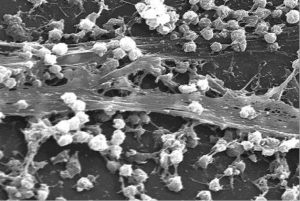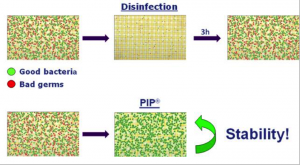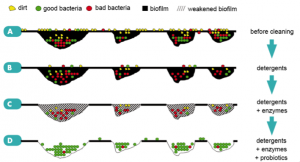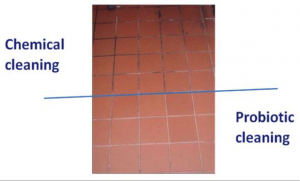How long do your kitchen surfaces stay clean?
I don't go for the 'One Weird trick to...blah blah' type of link bait. Statistics do often grab my attention, though, and then as a scientist I can analyse them to see if they are true. I found this one about a year ago, and it is about bacteria on household surfaces.
Let me ask you a question, and I will offer you three possible answers to it:
Q: Even when you use the strongest possible disinfectants on your household surfaces, how long does it take bad bacteria to start multiplying on that surface:
Is it
a) three hours
b) just over thirty minutes
c) three days
I will tell you the answer shortly. But let me ask you one more question:
Q: If you could use an all natural cleaner, non toxic, that reduced even really problematic bacteria like MRSA and C. difficile, you know the ones that Hospitals can't get under control, by as much as 80-90%, would you be interested?
The answer to my first question is a shocking 36 minutes. So you use all these heavy duty chemical disinfectants, where you and your loved ones live, and they don’t even work very well.
Thankfully, there is another, more natural, new and better way. Probisana Universal Cleaner – Probiotic, long lasting, more effective than the strongest chemical cleaner, and One Litre super concentrate makes 50 litres of Cleaner!
It has been shown to reduce:
- Number of S. aureus (MSSA, MRSA) bacteria – decreased by 80%
- Number of Clostridium difficile bacteria – decreased by 90%
Probiotic Cleaners
Antibiotics and the disinfectant era
A wide range of pathogenic (disease causing) bacteria and fungi cause numerous health problems in humans and animals. Some examples are Camphylobacter, Candida, Clostridium difficile, E. coli, Legionella, Listeria, Salmonella, Staphylococcus (MRSA hospital bacteria), and Streptococcus. In addition to the dangers that these organisms present all of us, they also provide huge economic losses such as increased animal mortality (agriculture), loss of production (food) and increasing health costs (hospital bacteria). Just look at the massive problems that the NHS has had with C. difficile and MRSA. The discovery of antibiotics and disinfectants offered a solution in the big fight against these bacteria. When in World War II the first antibiotic penicillin was applied in practice, this proved to be a panacea to suppress infection. In the decades that followed, these chemicals have been used plentifully. The assumption was that diseases and bacteria could be suppressed in this way forever.
Unfortunately, it soon became clear that certain bacteria began to resist the commonly used antibiotics. This means that a certain pathogen is no longer affected by a given dose of antibiotic. Healing is thus hampered.
In the next phase, multi-resistant bacteria appeared. These are bacteria that are resistant to different types of antibiotics. The known MRSA bacteria (which stands for Multi-Resistant Staphylococcus aureus) was one of the first to arise. This bacterium still causes major problems in hospitals worldwide.
The issue of multi-resistant bacteria led to the start of a dangerous development in general hygiene and cleaning. Suddenly there was a strong emphasis on the complete ‘sanitizing’ of an area. They used the philosophy that if you can not suppress it with antibiotics once they have caused illnesses, then it should just be killed on and around people with heavy duty chemicals.
The last ten years we have seen a dramatic increase in sales of disinfectants, which are becoming more normal in households, even though they contain dangerous chemicals. The consequences have been dramatic. In recent years, many of the bacteria have quickly developed resistance to these disinfectants. It is clear that the indiscriminate use of antibiotics age is coming to an end (according to the WHO). The same is true for heavy duty disinfectants, and that alternatives, such as probiotic cleaners, are necessary.
Biofilm

A biofilm is a complex aggregation of micro-organisms in a protective and adhesive matrix. Although innumerable different types of biofilm can arise, they do have some characteristics in common: they are attached to a (carrier) surface, have an irregular structure, are home to sometimes very diverse microbial communities and are strongly reinforced by the extracellular matrix of polymeric substances. In no time, the biofilm grows into a macroscopic structure with a very persistent matrix which protects the microorganisms from the outside world. A mature biofilm is a very complex structure in which the various micro-organisms interact with each other and each perform their own metabolic functions. Their common goal is shielding themselves from the outside world and the maintenance of the protective matrix. The extracellular matrix can be seen as the “glue” that holds the whole biofilm together. It consists of polymers, which are called collectively ‘extra cellular polymeric substances’ or exopolysaccharides (EPS). This matrix protects the cells and allows internal communications by using biochemical signals. There will also often be “channels” found in the matrix, which allow a transport of nutrients. It is known that micro-organisms in a biofilm will behave differently. More often than not they are pathogens and in particular are more resistant (up to 1000x) against antibiotics, detergents and biocides.
The Probiotic Cleaner Concept
Microbial management
One of the alternatives for disinfection is microbial management. Bacteria are vital for life on earth. The majority of bacteria are useful. It is therefore not advisable to get rid of them all. Instead, it may be better to strive for a healthy balance between the bacteria, so the risk from harmful bacteria will be much smaller. With microbial management you try to achieve a stable microflora in the area, not by fighting against the bacteria but fighting with them. This can be done by using Chrisal probiotic cleaners.
Figure 12: Microbial management

How to approach the biofilm
The formation and presence of biofilm is, as the name clearly states, a problem of a biological nature. It is known that a biofilm will act as a shield from strong and effective chemicals such as detergents, biocides and antibiotics. The only way to prevent the formation of biofilms and to remove existing instances efficiently, is by using biological infiltrators from inside to do their work. The probiotic bacteria in the Chrisal products ensure that:
- (1) The basic building blocks such as proteins, sugars, and glycerides will be consumed, and therefore are not available for the build-up of an extracellular matrix. This way they pro-actively avoid the formation of biofilm.
- (2) The present active biofilm will be broken down. The probiotic bacteria will be admitted to the biofilm, where they can act on the components of the matrix from the inside so that it is weaker. Chrisal bacteria also consume a large proportion of the nutrients, so that an increase or restoration of biofilm is prevented. Thus the existing biofilm will weaken and crumble.
- (3) After the removal of the biofilm, the surface will be kept clean

Composition of probiotic cleaning
In Probiotic cleaning products there are these so called “green” cleaning products that provide the first, superficial cleaning; the removal of visible dirt. To substantiate the green aspect of their products, Chrisal requested and obtained the Ecolabel for the non-probiotic version of the their products. They did this because the bacteria are not included in the current Ecolabel criteria. Chrisal products are thus Ecolabel products with the addition of probiotic bacteria.
Furthermore the probiotic cleaners contain a combination of enzymes and probiotic bacteria, which are responsible for the long lasting cleaning after effect. They provide a stabilization of the microflora on a surface. Besides cleaning, the probiotic bacteria also provide an “occupation” of the areas with harmless, good bacteria. As a result, there is no longer sufficient space available for food and other organisms that land on the surface and therefore reduces the risk of the development of harmful bacteria. With probiotic cleaners you actually do two things at once: on the one hand, a healthy microflora will be applied to the surfaces, on the other hand, you no longer use harmful chemical disinfectants so the resistance of bacteria is no longer encouraged.
Figure 14: Probiotic cleaning

To validate the effectiveness of the PIP Healthcare products a thorough study was conducted in collaboration with the Hospital of Lokeren, the University of Ghent and consultancy company Avecom NV. The approved by the ethics committee (og217) official clinical trial (B2652006814) showed that compared to conventional sanitizing / disinfecting the probiotic PIP Healthcare cleaning resulted in a distinctly safer and more hygienic hospital environment.
The average effect of PIP Healthcare cleaning for some bacterial groups were:
- Total bacterial count + 10%
- Number of coliforms (indicator hygiene) – decreased by 50%
- Number of S. aureus (MSSA, MRSA) bacteria – decreased by 80%
- Number of Clostridium difficile bacteria – decreased by 90%
More detailed results and study descriptions can be found in the study report by Ghent University and Avecom NV. Upon request.
Probisana Universal Cleaner – Probiotic, long lasting, more effective than the strongest chemical cleaner, and One Litre super concentrate makes 50 litres of Cleaner!
